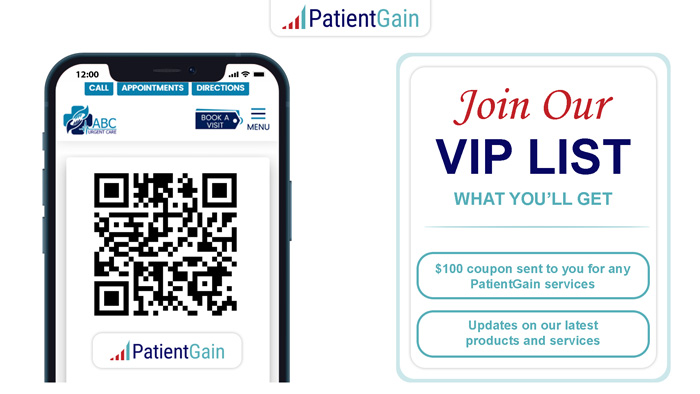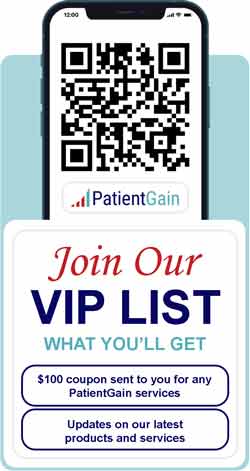Dental Practice Advertising Questions & Answers From Dentists and Dental Practice Managers
For a dental practice to be successful, they need to fill their calendar with patients every day of the week. While a dental practice location is undoubtedly essential, marketing will be vital in its success. In the highly competitive world of dental healthcare, you will need more than putting a sign out front and putting a listing in a phone book. Dentists need a sophisticated online dental marketing plan backed by the expertise and great software. The experienced team at PatientGain.com can help you market your dental practice and grow your business!
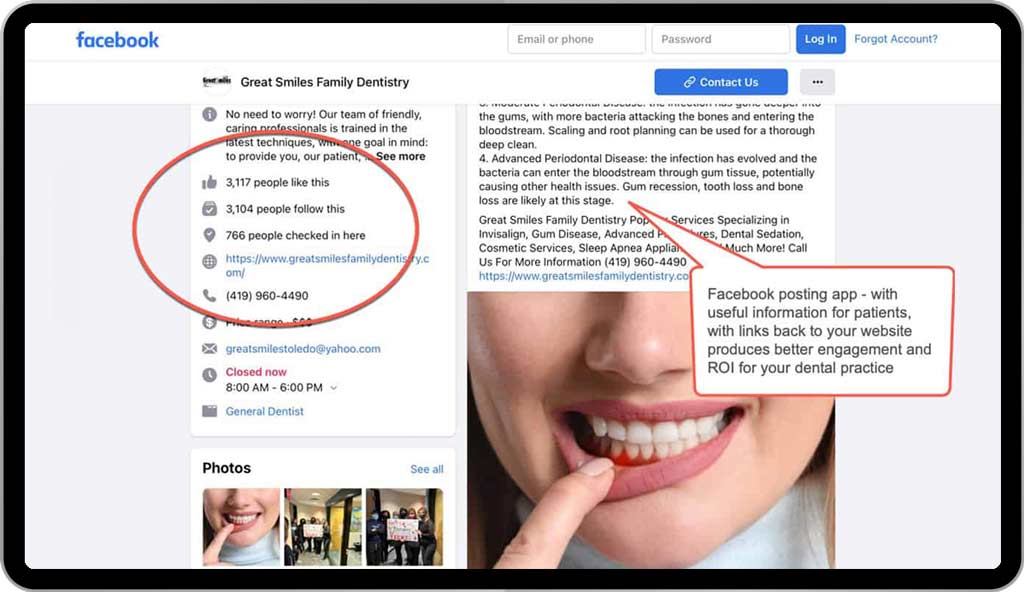
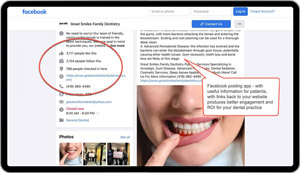
Dentists may have a state-of-the-art facility and the best providers in the area but can still struggle to fill appointment slots with returning or new patients. Even if they have a great-looking website, that alone may not be enough to meet their goals, succeed, and grow. A dental practice needs a medical marketing campaign as advanced as the equipment at their facility. Just as their providers are experts in dental care, the dental practice needs experts in the area of dental advertising. Fortunately, a dentist does not need to struggle to balance their time between patient care and marketing. The experts at PatientGain.com have helped countless dental practices promote their business, grow their patient count, and succeed!
Table of Contents:
1. Can dentists advertise in the USA?
2. Does a dentist need to advertise their dental practice?
3. Do successful dental practices advertise?
4. How much do dentists spend on advertising in USA?
5. What are the mistakes dentists make when running an online advertising campaign?
6. What percentage of dentists benefit from digital and online advertising of their practices?
7. What are six things dentists should focus on with the online advertising of their dental practice?
8. Should a dentist ignore traditional offline advertising and only concentrate on online advertising?
9. Offline advertising vs. Online advertising for dentists
10. What are some ways dentists can effectively advertise their dental practice?
11. What are some traditional, offline advertising techniques that may be useful to dentists?
12. What are the patient acquisition costs of a dental practice?
13. How can PatientGain.com assist with targeted advertising?
14. How can PatientGain.com help with optimizing a dental practice’s business presence?
15. How can PatientGain.com assist with social media for a dental practice?
16. Is Facebook Advertising or Google Advertising more effective for dentists?
17. What are PatientGain.com’s fees for managing an online advertising campaign?
1. Can dentists advertise in the USA?
Dentists can advertise in USA. However you can cannot advertise using misleading and in accurate statements or claims, per ADA (American Dental Association). However, unlike the late-night “As Seen On TV” commercials you may have seen, these advertisements do have rules they must follow. Online advertising for dentists must not be misleading or aggressive. A dentist can not put out inaccurate information or information that is not factual. Generally, this should not be a problem, but these regulations must be followed, or a dental practice may be banned from advertising on a platform. In addition, there are certain restrictions on keywords and phrases that can be used on Google, Facebook, Instagram and other platforms. There are also privacy laws that limit the data collected about patients. HIPAA is also a factor, when you use patient information in your advertising or marketing.
2. Does a dentist need to advertise their dental practice?
Yes! If you want to stand a chance to compete with your competitors, you do need to advertise your dental practice. The vast majority of potential patients looking for dental service will begin their search online. If you do not have a strong presence online already, you have already ceded ground to your dental competitors. PatientGain has helped boost the patient count for many dentists across the United States. Some dental practices have become so overwhelmed with new patients; we have had to scale back our online advertising efforts because they could not absorb additional patients.
3. Do successful dental practices advertise?
If a dental practice wants to compete with today’s competitors, yes, they do. Unless a dentist has the only practice around in a rural area of the country, they will have competitors. The best dental marketing plans have both offline advertising and online advertising. Of the two, online marketing will have a more considerable impact and take up more of the marketing budget. However, offline or traditional marketing should not be ignored and can, if used correctly, be a powerful tool to promote a practice. Refined and well-managed online and offline marketing campaigns can have a tremendous impact on the success of a dental practice. In fact, some of our clients at PatientGain.com have reduced or stopped online advertising altogether because past efforts have been so successful. They are currently at capacity and can not accept any additional patients! That is certainly a problem many dentists would like to have!
4. How much do dentists spend on advertising in USA?
Digital advertising spend from dentist to dentist, and also the location makes a big difference. If you are located in an area where there are many dentists competing for the same dental patient, then you will have to spend more on advertising. Unfortunately, there is no one standard number to apply to advertising for dental practices. In some cases, depending on the size of the dental practice and the surrounding competition, it could be $1,000 a day. At other dental practices, it may be $1,000 a month. Others spend even less and rely on their referral network and SEO rankings to maintain and grow their patient count. Every area is different and therefore requires different dental marketing plans and budgets. Even in the same area, different types of healthcare businesses will have vastly different marketing budgets. A plastic surgeon could spend over $15,000 a month in advertising, while a primary care doctor could spend as little as $600 a month. A dental practice needs to find a budget that works for them and remains competitive with other dental practices advertising in the area. It will take a little trial and error to find the sweet spot. An excellent place to start is about $3,000 a month and then evaluating if that is enough to cover a practice’s needs. Depending on a variety of factors, it may require more or less. Here are some general guidelines and data:
Dental practices – General dentists
The typical range is $750 to 2800 per month, spend on average spend $1830 per month per location.
Dental practices – General dentists with cosmetic focus (implants, braces, Invisalign)
These dental practices treat general dentistry patients, like cleaning, and yearly preventive exams, however their focus is big ticket items. This typically includes dental implants, Invisalign, and other similar services. The typical range is $2550 to 5800 per month, spend on average spend $3800 per month per location.
Dental practices – Specialist dentists
The typical range is $1300 to 3210 per month, spend on average spend $2240 per month per location. These type of practices include Endodontists, TMJ disorders, sleep apnea, oral appliances etc.
Dental practices – Celebrity & cosmetic focus
The typical range is $8300 to $18850 per month, spend on average spend $9600 per month per location. These type of practices include dentists who do not accept insurance, and accept limited amount of patients, but each patient is treated as a “celebrity” with extreme focus on customer service, and results for each patient. Services include Invisalign, porcelain veneers, whitening, bonding, laminates, implants, and orthodontics.
5. What are the mistakes dentists make when running an online advertising campaign?
Dentists know everything about teeth, but many are not too savvy when running online advertising campaigns. Below are the most common mistakes dentists make when conducting online advertising:
- Start and Stopping Campaigns – Some dentists make snap decisions and want to stop campaigns after a few days (or hours) if they do not see the expected results. Do not do this! Professional marketers need data to make judgments on the effectiveness of a campaign, and that takes time.
- Budget: Do not nickel and dime your online advertising. If your budget is too small in a highly competitive area, you will likely not see any tangible results. Support it with a robust budget, and you will see some changes.
- Jumping Between Advertising Mediums – “Putting all of your eggs in one basket” should not be your go-to phrase guiding your marketing decisions. If you decide to advertise somewhere, stick with it. Do not do Google AdWords one month, Facebook Ads another month, and then Instagram ads the following month. Commit to a medium and stick with it until you have enough data to make a decision. At PatientGain.com, we suggest putting 80% of your budget into Google PPC ads and the remaining 20% into social media ads, like Facebook.
- Setting Ads and Forgetting About Them: Dental Advertising Campaigns are not something you look at once and then revisit months later. They must be monitored, and adjustments should be made to your PPC campaigns. Your competitors will notice your ads and try to counter their impact. Keeping tabs on your ads will help you keep them effective.
- Sending Visitors To Non Relevant Content: Make sure your ads send people to specific pages relevant to the ad content. You should only send people to the home page if you are promoting the entire practice. If you are promoting a service, send them directly to that service page.
- Long Videos: Long videos are not going to be viewed and will cut into your engagement. Short videos produce the best results in terms of conversion. For better results, use “in-page” embedded videos.
6. What percentage of dentists benefit from digital and online advertising of their practices?
At PatientGain.com, we’ve found the vast majority (99%) will see an increase in the patient count when advertising campaigns are properly launched and maintain. However, setting up ads on Google and social media channels (like Instagram and Facebook) is not a point-and-click task that is easy to accomplish. When analyzing the online advertising campaigns of other dental practices when we were hired to help, we found problems and mistakes in most of them. Some of the most common mistakes we see include:
- Missing keywords
- Incorrect Settings
- No or not enough branded images
- Incomplete targeting
- Missing negative keywords
- Insufficient budgeting
- Poor campaign organization
The good news is that PatientGain.com has seen it all, so we can pick out the problems you may not see in your online campaigns. Our team can make a campaign more efficient and optimized!
7. What are six things dentists should focus on with the online advertising of their dental practice?
- Local SEO: Your dental practice should be listed in as many local directories as possible. Your listing should appear in search results and on Google Maps, Bing Maps, and Apple Maps. Create or claim your listing on Google, Facebook, Yelp, Bing, and Foursquare
- Speech SEO: More people are using “voice search” to get answers to questions, and more have smart devices at home they can talk to. Having your website formatted to provide answers to common dental questions is vital.
- Technical SEO: What goes on behind the scenes of a website is as important as its content. The structure of your website is key to boost site speed and make the user experience better. These play into overall SEO rankings.
- Online Advertising: Your dental practice should put up pay per click ads (PPC) on Google and Bing. Display ads and remarketing ads may also be useful to your business.
- Social Media Advertising: Many social media platforms have a way to advertise to their users through their channels. However, dentists often find the most successful advertising on Facebook and Instagram.
- Location-Based Ads: These ads display ads based on a patient’s physical location. Some dentists use geo-fencing to show ads to people based on the location of their phones. This allows you to refine your target audience by location.
8. Should a dentist ignore traditional offline advertising and only concentrate on online advertising?
While online advertising has surpassed offline advertising in terms of effectiveness and widespread use, a dentist should not wholly ignore offline advertising. Some dental practices may find these offline and traditional advertising mediums useful to their business:
- Billboards
- Newspapers
- Phone Books
- Radio Ads
- TV Ads
- Ads before the movie trailers in theaters
- Direct Mail
- Handouts and flyers
Offline advertising is notably harder to track and to gauge how effective it is performing. This advertising is also less agile, meaning you can not change things on the fly like you would with online advertising. It is also usually more expensive than online advertising. With that said, some ads can be effective in reaching a large group of people. Receiving something physical and seeing an online ad can be a powerful combination for a dentist. Offline advertising also reaches those who may not have immediate access to the online world and, therefore, would be missed by your online advertising efforts.
9. Offline advertising vs. Online advertising for dentists
Having a great-looking website and a sharp online marketing campaign may not generate enough new patients to fill the slot of a growing dental practice. In addition to online advertising, some offline advertising strategies may be needed to help the dental practice grow. Offline advertising can include:
- Radio ads
- TV ads
- Ads before movies in theaters
- Billboards
- Newspaper ads
- Ads in stores (IE Ads on diner placemats)
- Yellow Pages
- Direct mail marketing
Offline advertising is not as cost-effective today, and it can be challenging to track leads directly from these campaigns. Without tracking, it can be challenging to evaluate. Radio, TV, and Newspaper ads can reach a large audience. Still, if the footprint of these ads is too large, then a dental practice will be advertising to people who will be unlikely to consider a dental practice for treatment.
Direct mail marketing, however, has proven to be a cost-effective way to reach a community. Unlike other forms of offline marketing, there is a degree of targeting associated with it. A dental practice can determine where their marketing mailer is going in the area. Depending on the volume of mail being sent out and prepared, discounts may even be available from the United States Post Office. Although much offline marketing may not make sense for a dental practice, direct mail marketing may be worth considering and experimenting with for a business.
10. What are some ways dentists can effectively advertise their dental practice?
1. Targeted Advertising
The reason why offline or traditional advertising is perceived as being less effective is that it is difficult to target people. Sending out a flyer to everyone in a neighborhood is a great way to increase brand awareness, but not everyone who receives it will need a dentist. However, using pay-per-click advertising, you can display your ads when there is a good chance someone is looking for a dentist. It will not appear for “Italian Restaurants near me” but would appear for “teeth cleaning services near me.” By only showing your ad to those who might need your services, they will be more likely to click on it.
2. Improve your online SEO rankings
As a dental practice, you need to apply top-notch search engine optimization strategies to your dental website. These dental SEO (Search Engine Optimization) tactics will help grow your dental site’s organic rankings. The organic results google, bing, or other search engines display are 100% free. In addition, consider this: According to Search Engine Journal, 70% of the links search users click on are organic. Content of your dental website has the biggest impact on the SEO rankings of your dental practice.
Example of a very good SEO for a dentist:
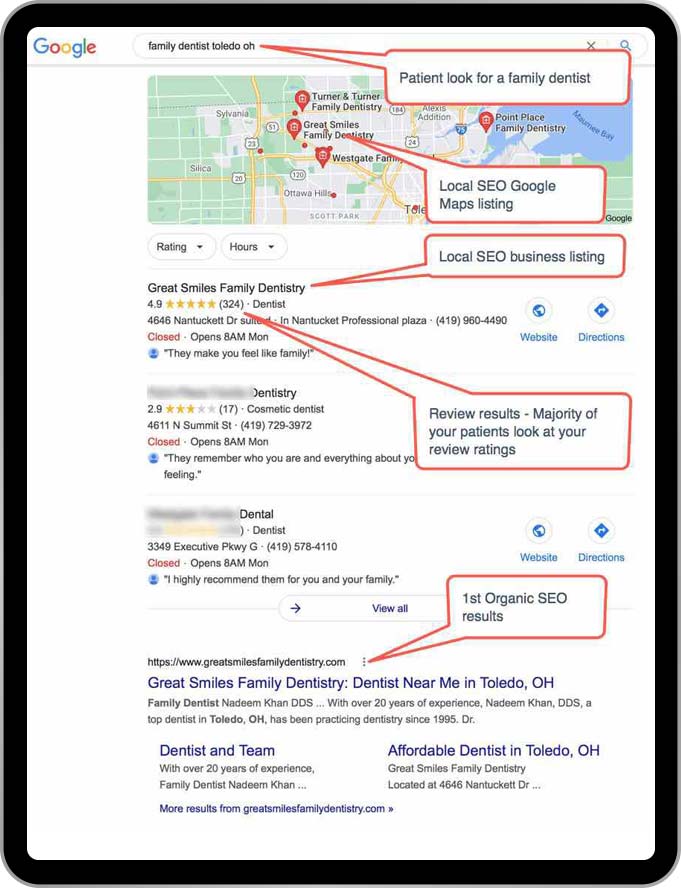
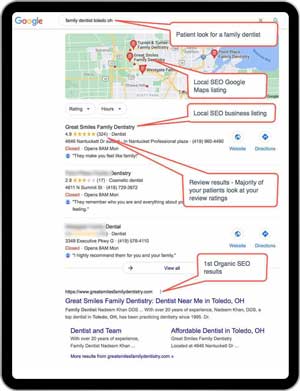
3. Improve your online business presence
To improve your online business presence, you need to be listed in online directories, like Google, Yelp, Facebook, Bing, and Foursquare. From there, you can manage your online reputation by asking for reviews and responding to any negative reviews. Your dental website needs to be designed so it is optimized for search engines and converts website visitors into patients. Patientgain.com has created many websites for dentists that effectively rank high in organic results and increases online conversions.
4. Create Profiles on Social Media
More and more doctors, not just dentists, find social media vital in their healthcare advertising efforts. There are many social media platforms out there; however, the most important ones you should be on include:
- Google Business Profile
You may notice that some of these overlap with directory listings, as mentioned in a previous section. Create social media profiles on these sites and embed the links onto your dental practice’s website. Keep your current patients up to date with announcements and find new patients by encouraging current patients, employees, and friends to share content on their profiles. Social media channels also have powerful advertising platforms that allow you to target potential patients in the area with ads. Social media can generate leads, boost conversions, and should be used as a professional business tool.
Some dentists have found it useful to also have profiles on Snapchat, Tiktok, and Pinterest. Unfortunately, these social media channels generally do not let you schedule posts in conjunction with posts on Facebook, Twitter, Instagram, and a Google Business Profile. As such, it may take more time out of a day to create content for these channels, and that may not be the best use of a dentist’s time or the person they assign to post on Social Media.
11. What are some traditional, offline advertising techniques that may be useful to dentists?
When used in conjunction with online advertising campaigns, some dentists have found these offline advertising mediums effective. Remember, unlike online ads, there is not much in the way of refining your target audience.
- Newspaper ads: If you are in a major metropolitan area, advertising in newspapers may not be the best use of your advertising money if a good part of the circulation is unlikely to come to your dental practice. However, in smaller towns with smaller newspapers, this would effectively reach a large majority of a target area.
- Direct mailing – The volume of advertisements being sent through the mail has declined over the last decade. A benefit to this trend is that your mailer will have less to compete with. Create an eye-catching marketing piece with a powerful call to action. Often, you can target what neighborhoods will get your flyer.
- Local bus ads – An ad on a bus stop or a bus can help if your dental practice is near mass transit. Advertising here usually requires a several-month commitment, and advertising messages dentists choose can not be updated. With that in mind, choose a message and call to action that will work for several months.
- Ads in local movie theaters– These ads are shown as people come in and sit before movie trailers. Some theaters show videos, and others will have a simple slide show. While shown in-person offline, the assets you send are digital, allowing you to update them as needed but not instantly.
- Billboard rentals – If your dental practice is near an area with high volume in terms of vehicle or foot traffic, a billboard may be the right choice for you. Billboards are expensive and do require a multi-month commitment. Some billboard companies also offer other online display ads with contracts. Like bus stops, these ads are locked in and can not be changed.
- Electronic Billboard Rentals – Electronic billboards, being a big screen where ads are displayed and rotate through different ads, are becoming more common. They are like display ads you would see on a website, but instead, they are shown along a highway. Unlike traditional billboards, you can update the message you display. However, you will be sharing this space with other advertisers, and you often have to commit to a certain amount of advertising budget.
- Hosting special events – While special community events generally are not something you associate with dental practices, a community dental check-up event in conjunction with other health care businesses at a community event can be a great way to get potential leads.
- Radio advertising – Radio advertising is only beneficial if most people who hear your ad can visit your dental practice. If you are on the outskirts of a major city, it may not be useful. If your practice is in the heart of the city, then you will get a higher ROI. In smaller markets, this could be a cost-effective way to reach an area. While your radio ad cannot be targeted to a specific audience as refined as an online ad, you can do some targeting by examining the typical demographic that listens to the radio station.
- TV advertising – Like radio advertising, your location in the broadcast area will determine how effective your ad will be and if it is worth the cost. Channels that broadcast over a large area may be too expensive for your dental practice. Cable providers have started to deploy technology that allows you to target by county or city. They also can provide you demographics of the type of people who generally watch a channel where your ad will appear.
- Advertising in Local School Programs – Sports, theater, and other school activities are always looking for sponsors. Depending on your target audience, advertising here could be a great way to get your ad in front of eyes while also supporting your local community.
- Sidewalk Advertising – Do not neglect what people see outside of your dental practice. A great sign can attract interest and walk-in traffic looking for more information about the services you offer.
12. What are the patient acquisition costs of a dental practice?
PatientGain.com has run thousands of advertising, marketing, and email marketing campaigns for various healthcare companies over the years. Overall, we have found that the costs to acquire a new patient can range between $8 and $27. Competition in an area is usually the driving force behind high patient acquisition costs. For a dental practice to be successful in their online advertising, they need to keep in mind three areas of the marketing plan: Targeted advertising, Optimized Business Presence, and Social Media. PatientGain.com can help a dental practice in these area to become more successful by deploying specifically designed applications.
13. How can PatientGain.com assist with targeted advertising?
Pay-Per-Click advertising is crucial to many dental practice marketing plans. PatientGain.com can help run these campaigns on all major search engines: Google, Bing, and Yahoo. We can also help with remarketing campaigns as well as social media advertising on Facebook and Instagram. When correctly optimized, these campaigns can generate significant leads and increase patient count. PPC advertising allows the dental practice to promote services and keywords that do not have an organic ranking to compete with other competitors in the area. PatientGain.com can design ads and campaigns so that a dental practice’s target audience can be exposed to its brand and learn more about the facility’s services.
14. How can PatientGain.com help with optimizing a dental practice’s business presence?
- Optimize directory listings
- Optimize online reputation
- Cultivate online reviews
- Optimize website to improve organic rankings
- Optimize website for conversion using intelligent apps
- Optimize ads to lead patients to pages with information they need
- Deploy apps, such as a medical engagement chatbot, to help with website conversions
- Create a mobile friendly experience
15. How can PatientGain.com assist with social media for a dental practice?
- Optimize profiles on Facebook, Google Business Profile, Yelp, Instagram, and others
- Integrate apps into Facebook Pages to capture leads and patient data
- Track potential patients visiting the website from social media profiles and advertising
- Optimize social media profiles, so they look more professional
16. Is Facebook Advertising or Google Advertising more effective for dentists?
Advertising on Facebook can be very effective and can produce many leads, as does Google Search advertising. However, the experts at PatientGain.com have found that Google Search ads generally perform better than ads on Facebook. The effectiveness of ads and which platform is better can be impacted by what is being advertised, how it is being promoted, the area of dental care a practice specializes in, and the target audience. Every campaign, ultimately, is different. However, overall, PatientGain.com has seen a greater Return on Investment (ROI) for dentists using Google Search Advertising than Facebook Advertising.
17. What are PatientGain.com’s fees for managing an online advertising campaign?
At PatientGain.com, we charge a flat 18% flat fee for online marketing campaigns based on the budget for that month. There is base service fee and then there is a percentage fee. For example:
Budget – $1000 Charge – $150
Budget – $2000 Charge – $300
Budget – $10,000 Charge – $1,500
This fee is charged after spending your money on ads and is not taken out of your ad budget. Some companies will take their flat fee out of the budget, resulting in a higher management fee percentage.

